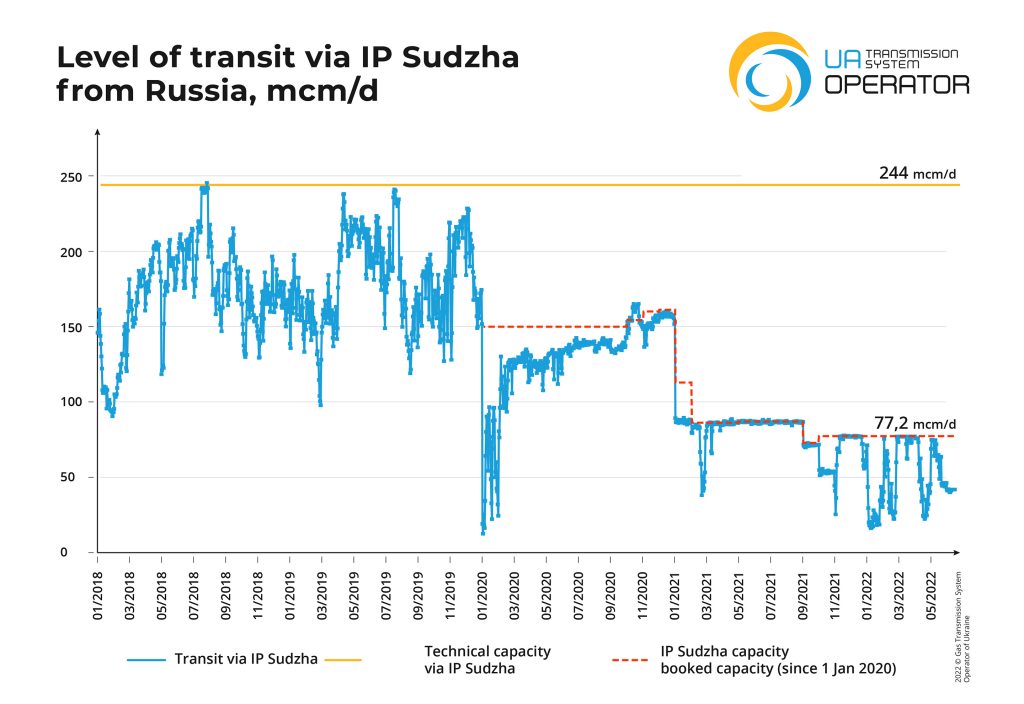Due to a significant number of appeals from European customers about the possibility of increasing the transit of natural gas through Ukraine against the backdrop of reducing the volume of transmission through Nord Stream-1, GTSOU informs about the following:
As of 15 June 2022, the capacity of the Ukrainian GTS booked and paid for by Gazprom at the Sudzha entry point amounts to 77.2 million cubic meters per day. The current actual level of transit does not exceed 42 million cubic meters per day. Gazprom can use 35 million cubic meters per day of booked capacity without additional actions or costs.
Moreover, for the duration of the force majeure at the Sokhranivka entry point (due to unauthorized gas offtakes by the occupation administration and interference with the operation of Ukraine’s GTS facilities in the occupied territories), GTSOU provided the opportunity to Gazprom to transfer the booked capacity from the Sokhranivka IP to the Sudzha IP in the amount of 32.4 million cubic meters per day. But the Russian company also did not use this option.
In compliance with the requirements of the GTS Code of Ukraine and the Third Energy Package of the EU, GTSOU puts up for sale on the RBP auction platform additional 15 million cubic meters per day at the Sudzha interconnection point.
Therefore, Gazprom has an opportunity to increase transit through Ukraine by 82.4 million cubic meters per day, which fully compensates for the decrease in amounts through Nord Stream – 1.
The technical capacity of the Sudzha interconnection point is about 244 million cubic meters per day. To facilitate the preparation of European countries for the next heating season, GTSOU is ready to consider an additional temporary increase in transit amounts to amounts that can compensate for the lack of transmission through Nord Stream-1, subject to a relevant request from Gazprom.
In addition, the Yamal-Europe pipeline, which transits natural gas from Russia to Germany via Poland and has a capacity of about 90 million cubic meters per day, has not been used for more than a month. Accordingly, if Gazprom does not want to book the capacity of the indicated pipeline, its customers have an opportunity to do so themselves, having determined the border between Poland and Belarus as the gas delivery point.
In viewing the above, we underline that the existing capacities for gas transit (with a significant part of them already booked but not used) are more than sufficient to compensate for the reduction in transmission via Nord Stream-1.

“Currently, Russia is declaring technical problems on their side that will lead to reducing gas supplies via Nord Stream-1 by 100 mcm per day. As a reliable supplier, Gazprom should also bring a solution in addition to voicing the problem. Such a solution could be reorientating gas flows to other gas pipelines in Poland or Ukraine. It is exactly what GTSOU did a month ago during the force majeure at the Novopskov CS – it offered additional capacity through another interconnection point. Already reserved and paid capacities of the Ukrainian GTS can transport these volumes of gas, -noted Sergiy Makogon, CEO of GTSOU. – Still, the booked capacities of the Ukrainian GTS are currently used only by 36%. So, the issue is not in commerce but politics. Gas has again become a part of Russia’s hybrid weapons and a tool for political pressure on the EU.”
